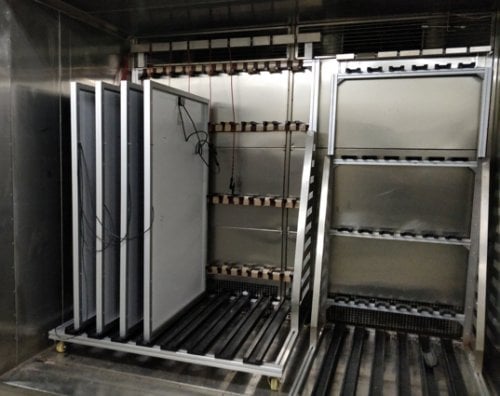IEC 61215 Certification Testing for solar modules
IEC 61215 is the standard which indicates the requirements for the design approval and qualification process and type approval of terrestrial PV modules suitable for long-term operation in general open air climates.
What is IEC 61215 Certification Testing?
The IEC is a leading global organization which develops consensus-based international standards for different electric technologies. These standards are developed based on field experience and are updated regularly. The IEC 61215 is the standard which should be applied to all flat crystalline silicon terrestrial plate modules.
The IEC 61215 standard outlines many required standards that comply with the actual requirements of the PV industry. It aligns the requirements for different crystalline Si technologies for manufacturers and provides a clear structure of general requirements and the test methods and techniques.
It also provides minimum design requirements which assure the safety of the product during normal operation. The IEC 61215 standard contains a total of 19 Module Quality Tests (MQT).
The purpose of the test sequence specified in IEC 61215 is to define the electrical and thermal characteristics of the module and to try to reflect-with minimum cost and time- that the module is able to withstand long time exposure in all different climates described in the scope. The IEC 61215 standard defines different PV dependent technologies and all related modifications to the testing procedures and requirements per the updated IEC 61215-1:2016 and IEC 61215-2:2016.
Why do we perform IEC 61215 Certification testing on PV modules?
The main purpose of the IEC 61215 is raising the quality standards of the PV manufacturing and ensuring the reliability of the modules while meeting customer requirements. The IEC61215 Certification provides qualification of integrity of PV modules.
The IEC61215 Certification is used to test the manufactured solar modules for many defects that may occur during the manufacturing process and also guarantee the efficiency of the modules and their lifetime performance in field installations. It also assures quality inspection of photovoltaic modules for different criteria that can’t be identified by visual or naked eye inspection
The IEC standard updates describe testing structures, minimum design requirements and qualification conditions –like clearance and creepage distances– in order to guarantee safe operation at high voltages.
How is IEC 61215 Certification testing performed?
IEC 61215 testing simulates temperature or/and humidity conditions by putting the modules through specific tests that measure environmental, performance, mechanical and safety aspects of the solar panel.
IEC 61215 consists of 19 Module Quality Tests, including:
- Temperature cycling
- Outdoor exposure test
- UV preconditioning
- Humidity freeze test
- Damp heat test
- Hail test
These tests are done in different sequences outlined in the standard. After the initial tests, the modules are separated and subjected to one of the different sequence tests. The sequences are called A, B, C, D or E, and after that tested again for efficiency and safety. Each single sequence contains stress tests which specifically aim at clarifying one of the identified main degradation causes that are commonly faced in the field.
IEC 61215 Test Sequences:
- Sequence A is the control sequence which contains mild conditions that provide basic characterization for the modules under STC (Standard Test Conditions).
- Sequence B tests the hot spots and outdoor behavior.
- Sequence C combines various stress tests in which the modules are initially preconditioned with UV light and after subjected to 50 thermal cycles and 10 humidity freeze cycles.
- Sequence D contains the thermal cycling test in which the module is subjected to 200 thermal cycles.
- Sequence E combines the damp-heat test together with the mechanical stability tests.
The above sequences ensure the PV modules are tested for all the important parameters which include basic Diagnostic tests, Electrical parameters, Performance Parameters, Thermal, irradiance, Environmental and mechanical parameters.
What are common problems detected during IEC 61215 certification testing?
The modules are approved when they pass the requirements of each sequence. In case of one module failure, two additional new modules are tested again for the respective sequence. In general, the degradation should not be more than around 5% after each module test. Another general passing criteria is that after each test the wet leakage current test should be repeated, and no evidence of any visual defect should be seen.
The IEC 61215 tests detect many defects like cracks, decrease of conversion efficiency, de-lamination of modules.
Other defects like:
- Failure of components and connections, like busbar failure or contact defects
- Failure of components in extreme outdoor conditions
- Detection of leakage and moisture effect on the PV modules and their performance
- Short circuit in solar cells
Order PV Module Laboratory Testing
Note: Sinovoltaics only offers laboratory testing in combination with quality inspections or audits at the manufacturers.
By contacting Sinovoltaics you agree to our Privacy Policy.


